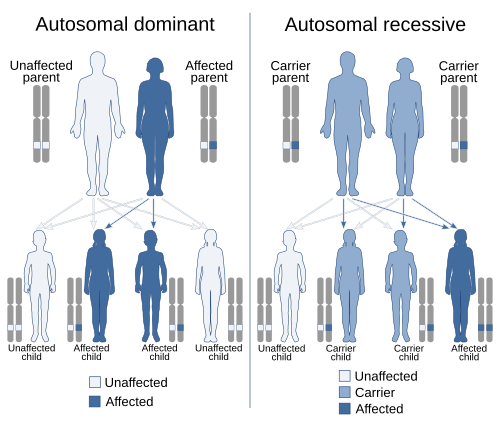
Back Dominansie (genetika) Afrikaans سيادة (وراثة) Arabic Dominància genètica Catalan ХӀучӀогӀалла CE زاڵی (بۆماوەزانی) CKB Dominance (genetika) Czech Dominansforhold Danish Dominanz (Genetik) German Dominant u resesif DIQ Dominanteco (genetiko) Esperanto
This article needs additional citations for verification. (February 2018) |

In genetics, dominance is the phenomenon of one variant (allele) of a gene on a chromosome masking or overriding the effect of a different variant of the same gene on the other copy of the chromosome.[1][2] The first variant is termed dominant and the second is called recessive. This state of having two different variants of the same gene on each chromosome is originally caused by a mutation in one of the genes, either new (de novo) or inherited. The terms autosomal dominant or autosomal recessive are used to describe gene variants on non-sex chromosomes (autosomes) and their associated traits, while those on sex chromosomes (allosomes) are termed X-linked dominant, X-linked recessive or Y-linked; these have an inheritance and presentation pattern that depends on the sex of both the parent and the child (see Sex linkage). Since there is only one copy of the Y chromosome, Y-linked traits cannot be dominant or recessive.[3] Additionally, there are other forms of dominance, such as incomplete dominance, in which a gene variant has a partial effect compared to when it is present on both chromosomes, and co-dominance, in which different variants on each chromosome both show their associated traits.
Dominance is a key concept in Mendelian inheritance and classical genetics. Letters and Punnett squares are used to demonstrate the principles of dominance in teaching, and the upper-case letters are used to denote dominant alleles and lower-case letters are used for recessive alleles. An often quoted example of dominance is the inheritance of seed shape in peas. Peas may be round, associated with allele R, or wrinkled, associated with allele r. In this case, three combinations of alleles (genotypes) are possible: RR, Rr, and rr. The RR (homozygous) individuals have round peas, and the rr (homozygous) individuals have wrinkled peas. In Rr (heterozygous) individuals, the R allele masks the presence of the r allele, so these individuals also have round peas. Thus, allele R is dominant over allele r, and allele r is recessive to allele R.[4]
Dominance is not inherent to an allele or its traits (phenotype). It is a strictly relative effect between two alleles of a given gene of any function; one allele can be dominant over a second allele of the same gene, recessive to a third, and co-dominant with a fourth. Additionally, one allele may be dominant for one trait but not others.[5] Dominance differs from epistasis, the phenomenon of an allele of one gene masking the effect of alleles of a different gene.[6]
- ^ "dominance". Oxford Dictionaries Online. Oxford University Press. Archived from the original on July 18, 2012. Retrieved 14 May 2014.
- ^ "express". Oxford Dictionaries Online. Oxford University Press. Archived from the original on July 18, 2012. Retrieved 14 May 2014.
- ^ Eggers, Stefanie; Sinclair, Andrew (2012). "Mammalian sex determination—insights from humans and mice". Chromosome Res. 20 (1). Dordrecht: Springer-Verlag: 215–238. doi:10.1007/s10577-012-9274-3. hdl:11343/270255. ISSN 0967-3849. PMID 22290220.
- ^ Bateson, William; Mendel, Gregor (2009). Mendel's Principles of Heredity: A Defence, with a Translation of Mendel's Original Papers on Hybridisation. Cambridge University Press. doi:10.1017/CBO9780511694462. ISBN 978-1108006132.
- ^ Billiard, Sylvain; Castric, Vincent; Llaurens, Violaine (2021). "The integrative biology of genetic dominance". Biol Rev Camb Philos Soc. 96 (6). Oxford, UK: Oxford, UK: Blackwell Publishing Ltd: 2925–2942. doi:10.1111/brv.12786. PMC 9292577. PMID 34382317.
- ^ Griffiths AJF; Gelbart WM; Miller JH; et al. (1999). "Gene Interaction Leads to Modified Dihybrid Ratios". Modern Genetic Analysis. New York: W. H. Freeman & Company. ISBN 978-0-7167-3118-4.
© MMXXIII Rich X Search. We shall prevail. All rights reserved. Rich X Search